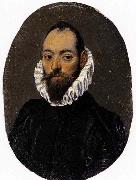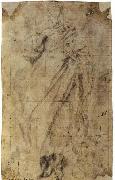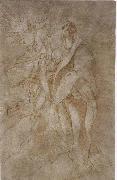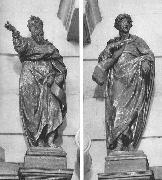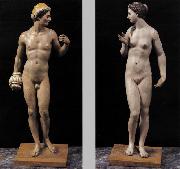
|
Artists
Index
|
||
|
El Greco
|
||
|
Portrait of a Man new21/El Greco-487884.jpg Måleriet identifieringen:: 62291 |
1586-90 Oil on cardboard, 7,9 x 5,7 cm The Hispanic Society of America, New York Work by El Greco in small format, which includes miniatures, small-scale religious paintings and reduced versions of larger compositions, is well documented from the time of his residence in Italy onwards. Yet this interesting portrait miniature remains one of the few known in his oeuvre. It bears an original signature on the back | |
| |
|
|
|
|
||
|
St John the Evangelist new21/El Greco-596964.jpg Måleriet identifieringen:: 62292 |
1577 Black chalk with traces of white, on yellowish paper, 255 x 155 mm Biblioteca Nacional, Madrid The drawing is a study for St John the Evangelist, one of the six canvases that El Greco painted for the altarpiece on the High altar of Santo Domingo el Antiguo in Toledo The drawing, now considerably faded, served a practical purpose. The squaring of the sheet indicates that it was used to transfer the design on to the full-scale canvas. In many respects the painting follows the drawing very closely: the arrangements of the hands, feet and draperies are virtually identical | |
| |
|
|
|
|
||
|
Study for St John the Evangelist and an Angel new21/El Greco-547657.jpg Måleriet identifieringen:: 62293 |
1596-99 Pen and pale-brown ink and wash on off-white paper, 337 x 210 mm J. Paul Getty Museum, Los Angeles This is one of he very few drawings universally accepted as by El Greco. It is a study for the Crucifixion in the Prado, Madrid. It shows the figure of St John the Evangelist, who in the painting is stationed at the foot of the cross on the right side looking up at the crucified Christ. The pose and the gestures are virtually identical. The principal difference is in the figure of the angel, who in the drawing is very close to the saint, whereas in the painting the figures do not overlap at all | |
| |
|
|
|
|
||
|
Two Saints new21/El Greco-588648.jpg Måleriet identifieringen:: 62294 |
1577-79 Wood, height about 150 cm Santo Domingo el Antiguo, Toledo The sculptures decorating the altar of Santo Domingo were executed by the Escorial artist J. B. Monegro after designs by El Greco | |
| |
|
|
|
|
||
|
Epimetheus and Pandora new21/El Greco-864667.jpg Måleriet identifieringen:: 62295 |
1600s Polychromed wood, height: 43 cm Conde de la Infantas Collection, Granada A few sculptures, including these two strange nudes, have been attributed to El Greco. This attribution is doubtful, however. It is based on the testimony of Pacheco, who saw in El Greco's studio a series of figurines of wax, stucco, and wood, but these may have been merely models, like those used in the Italian workshops where El Greco was trained. The figures illustrated recall certain nudes in paintings by El Greco in their elongated proportions, their supple postures, and their opposition in contrapposto. Nevertheless, they also evoke certain Florentine mannerists, Sansovino or Cellini, and their naturalism and the accentuated musculature of the male figure are surprising for El Greco. The identification of the statuettes is also problematical. Originally thought to represent Adam and Eve or even Vulcan and Venus, they were correctly identified as representing Epimetheus and Pandora in 1961. According to the Greek poet Hesiod, Pandora was the first woman, created from the earth and water. She was brought to life with heavenly fire and married Epimetheus, the brother of Prometheus. Zeus gave her a beautiful box containing all manner of evils and calamities and Pandora or according to some versions of the myth, Epimetheus, opened it, releasing them into the world. These small statuettes are carved in wood and painted in oils, the traditional materials of Spanish polychrome sculpture. They are undocumented works but the attribution to the artist is generally accepted | |
| |
|
|
|
|
||
| Föregående Konstnär Nästa Konstnär | ||
|
Also Buy::. For Following Paintings / Artists / Products, Please Use Our Search Online: |





